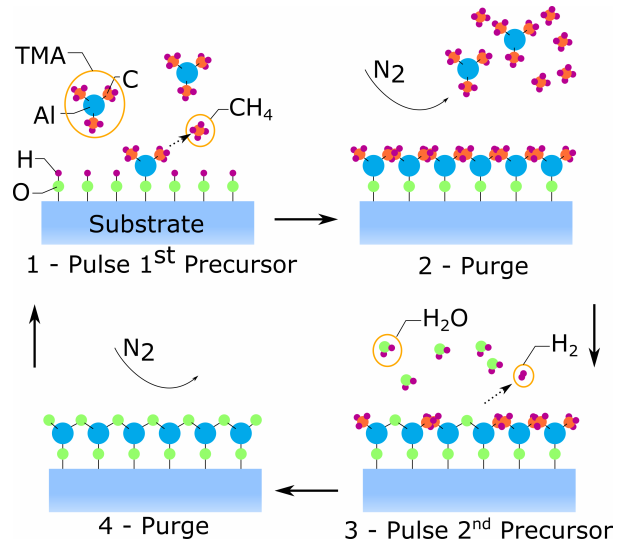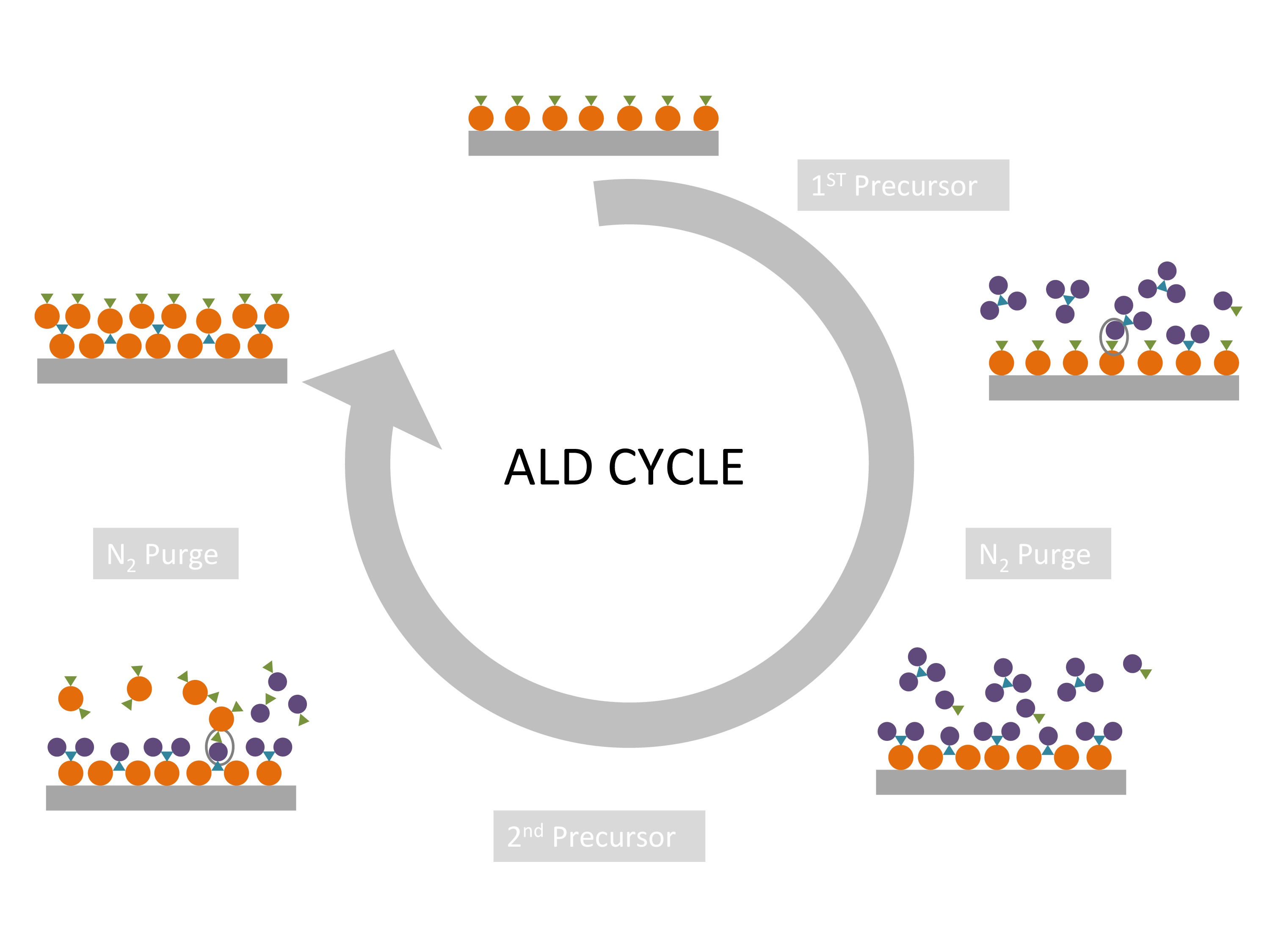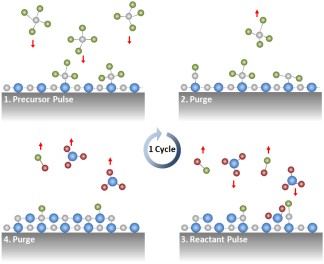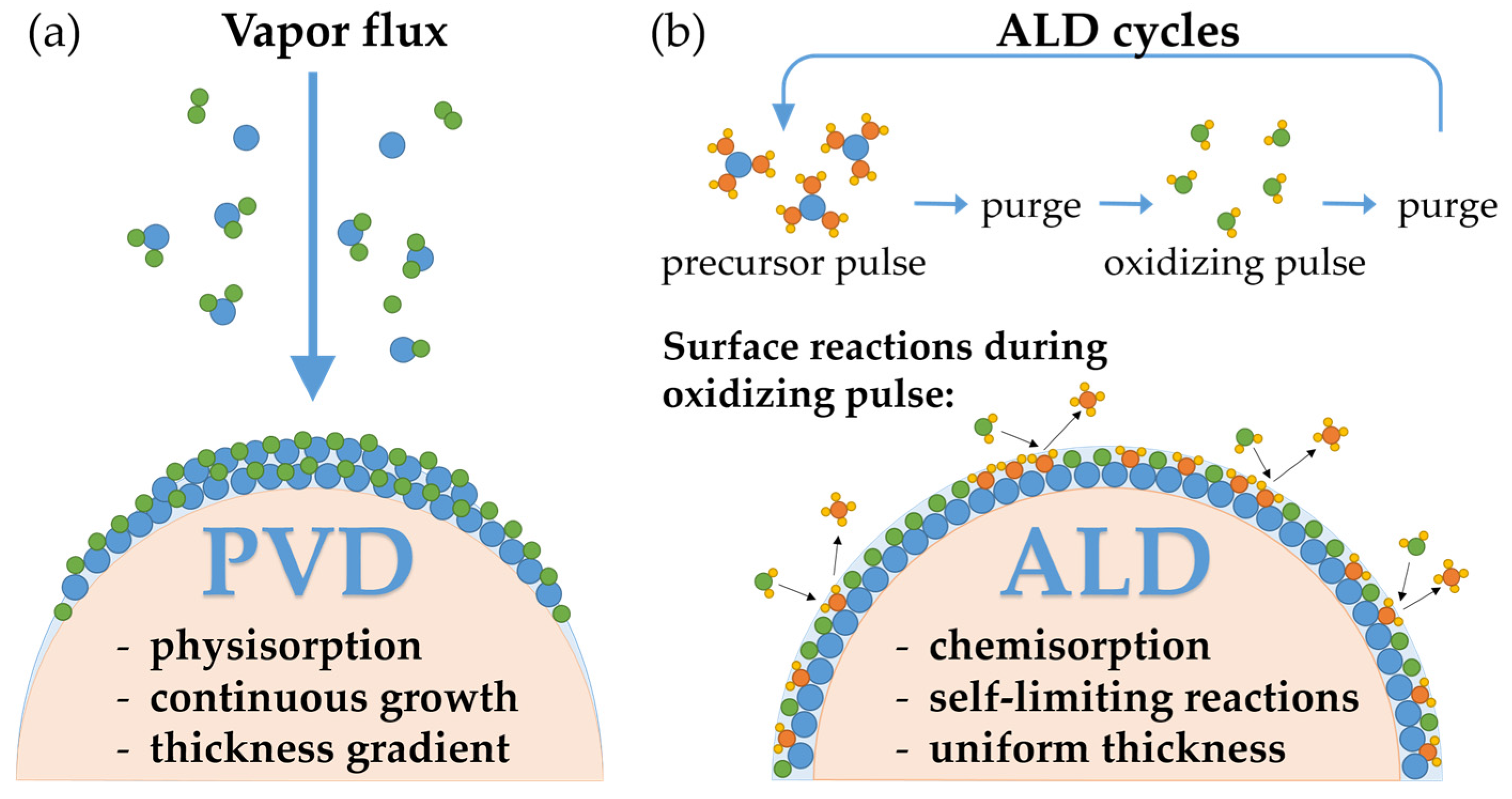Kurt J. Lesker Company

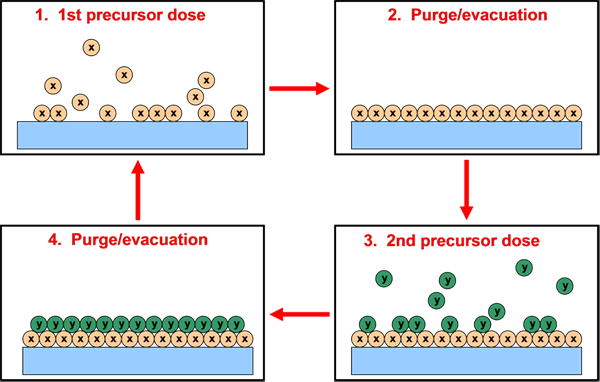
Reduced nucleation delay• Yu Lei, an associate professor in the Department of Chemical Engineering. Based on sequential, self-limiting reactions, ALD offers exceptional conformality on high-aspect ratio structures, thickness control at the Angstrom level, and tunable film composition. ALD has the potential to offer true nanoscale-thick surface depositions, which are highly conformal and pinhole free [34—37]. The thin films and coatings produced using ALD help to make these products even smaller yet and maintain the high standard of performance we demand in our consumer electronics. A wide range of materials can be deposited using PALD, including oxides, metals, sulfides, and fluorides, and there is a wide range of properties that these coatings can exhibit, depending on the application. In this review, we provide a brief introduction to ALD and highlight select applications, including Cu In,Ga Se 2 solar cell devices, high-k transistors, and solid oxide fuel cells. The improvement in the electrochemical performance is dependent upon the type of coating material. This section gives an overview for MEMS engineers of the basic operation principles of ALD, describes ALD processes and materials developed, discusses the characteristics of ALD processes and films as well as summarizes the available ALD reactor configurations. A variety of materials have been deposited with ALD. Lee, Enhanced stability of LiCoO 2 cathodes in lithium-ion batteries using surface modification by atomic layer deposition, J. The dissociative chemisorption of TMA leaves a surface covered with AlCH 3. Advanced Functional Materials 2020, 30 15 , 1910062. Precisely Engineered Photoreactive Titanium Nanoarray Coating to Mitigate Biofouling in Ultrafiltration. Some representative examples are shown below. Kim, Moon-Hyun Hwang, Kyu-Jung Chae. TEM images of A the uncoated UC ; B 50 cycles; C—D 100 cycles of CeO 2 ALD-coated LiMn 2O 4 particles; charge—discharge cycle curves of cells coated with various oxides at a 1 C rate in a voltage range between 3. Consequently, the maximum amount of material deposited on the surface after a single exposure to all of the precursors a so-called ALD cycle is determined by the nature of the precursor-surface interaction. Guo, Zheng; Li, Hao; Chen, Qiang; Sang, Lijun; Yang, Lizhen; Liu, Zhongwei; Wang, Xinwei 8 September 2015. Accommodates up to ten precursor sources with two separate chamber inlets• Liping Fang, Haolin Li, Xuhang Ma, Qiuming Song, Rui Chen. In DRAMs , the conformality requirements are even higher and ALD is the only method that can be used when feature sizes become smaller than 100 nm. In ALD, enough time must be allowed in each reaction step so that a full adsorption density can be achieved. The readers are suggested to refer [42,43] as extended reading to learn more about the fundamentals and application of ALD. Lei Wenwen; Li Xingcun; Chen Qiang; Wang Zhengduo February 2012. Archived from PDF on 14 July 2014. Materials Science and Engineering: B 2018, 236-237 , 139-146. Basics of Atomic Layer Deposition: Growth Characteristics and Conformality. Metal films [ ] Motivations of an interest in metal ALD are:• Charles Ng Wai Chun, Husnul Azan Tajarudin, Norli Ismail, Baharin Azahari, Muaz Mohd Zaini Makhtar, Leong Kah Yan. ; Heeg, Mary Jane; Winter, Charles H. An overview of the materials synthesized by ALD with 1 or more publications describing the process, an up-to-date figure can be obtained online under the for general use. In MEMS, ALD has been used since the early 2000s for a variety of purposes, for example, creating electrical, optical, chemical and tribological functions. The thickness of the deposited films can be controlled by simply counting the number of ALD process cycles. These two factors are emphasized in this chapter. Both of these systems are ideally suited to meet even the most demanding challenges associated with next generation 3D nanotechnology. "Like the household humidifier, ultrasonic atomization generates a mist consisting of saturated vapor and micro-sized droplets," he says. Atomic-Layer-Deposited Thin Films for Silicon Nanophotonics; SPIE Newsroom. 9 To confirm this, the thickness or material increase is to be determined per cycle, which is called the growth per cycle GPC. Chromium metal was deposited using a chromium precursor and BH 3 NHMe 2. Weber, Graniel, Balme, Miele, Bechelany. The number of reactor manufacturers increased rapidly and semiconductor applications became the industrial breakthrough of the ALD technology, as ALD became an enabling technology for the continuation of. Kevrekidis, Michael Tsapatsis. Matthieu Weber, Jin-Young Kim, Jae-Hyoung Lee, Jae-Hun Kim, Igor Iatsunskyi, Emerson Coy, Philippe Miele, Mikhael Bechelany, Sang Sub Kim. Atomic layer deposition is also gaining popularity in the biomedical industry, especially with the increase of nanoporous materials being used in drug delivery, tissue engineering, and implants. During the TMA exposure, TMA dissociatively chemisorbs on the substrate surface and any remaining TMA is pumped out of the chamber. The dose-purge-dose-purge sequence of a binary ALD process constitutes an ALD cycle. A characteristic feature of ALD is that the precursors are pulsed alternately, one at a time, and separated by inert gas purging in order to avoid gas phase reactions Figure 1. or its licensors or contributors. Enhanced photoelectrochemical performance of atomic layer deposited Hf-doped ZnO. The early roots of ALD extend to the 1960s although microelectronics industry boosted ALD to mainstream technology later on. The thickness achieved with each ALD cycle is process specific but it is usually in subnanometers. Although chemical protection from the environment can already be achieved with thin coatings, protection against mechanical wear might be limited. In addition to selecting the precursor it has to be determined how the precursor will be delivered to the chamber: vapor drawn, carrier gas assisted i. Influence of ALD Coating Layers on the Optical Properties of Nanoporous Alumina-Based Structures. Angewandte Chemie 2021, 332• Nitrides: TiN, TaN, Si 3N 4, AlN, GaN, WN, HfN, NbN, GdN, VN, ZrN• Etches Al 2O 3, HfO 2, SiO 2, Si 3N 4• "Trends in Copper Precursor Development for CVD and ALD Applications". The remaining reactant molecules are flushed away and only then reactant B is inserted into the reactor. Unsourced material may be challenged and removed. ALD is a CVD-based method for growing thin films with high precision. Excellent film uniformity• 16A and CeO 2 ALD-coated Fig. The crystal lattice structure achieved is thin, uniform, and aligned with the structure of the substrate. "Thermal Atomic Layer Deposition of Titanium Films Using Titanium Tetrachloride and 2-Methyl-1,4-bis trimethylsilyl -2,5-cyclohexadiene or 1,4-Bis trimethylsilyl -1,4-dihydropyrazine". However, certain material properties such as composition and resistivity can also be important with respect to uniformity. Schematic illustration of a typical ALD cycle consisting of two half-cycles. Boulos Alfakes, Corrado Garlisi, Juan Villegas, Abdulrahman Al-Hagri, Srinivasa Tamalampudi, Nitul S. High-resolution TEM images in Fig. high- and low- metals for. ALD can be used to form a barrier on plastics in roll to roll processes. Other aspects: Are aspects such as safety, stability, reproducibility, etc. Highly efficient hydrogen sensors based on Pd nanoparticles supported on boron nitride coated ZnO nanowires. NH3, O2 2 plasma gases e. Nanomaterials 2019, 9 11 , 1552. Crystallinity of Inorganic Films Grown by Atomic Layer Deposition: Overview and General Trends. The ALD cycle can be performed multiple times to increase the layers of the thin film, depending on the requirement. 1 Atomic Layer Deposition Atomic Layer Deposition ALD techniques can produce continuous, Angstrom-level-controlled, and defect-free films. In corrosion protection, heterogeneous surfaces with unknown and varying composition are common. Effective metal chemistry through use of hydrogen plasma• A 3D nm-thin biomimetic membrane for ultimate molecular separation. TFEL flat panel display production started in the mid-1980s by Lohja Oy in the Olarinluoma factory. with ideally no variation in thickness along the structure. Rosy Eko Saputro, Ahmad Taufiq, Nurul Hidayat, Sunaryono, Yuanita Amalia Hariyanto, Arif Hidayat. Its application between the depositions of each layer by ALD provides information on the growth rate and material characteristics of the film. Beilstein Journal of Nanotechnology 2019, 10 , 746-759. Kang-Hee Park, Peng-Fei Sun, Eun Heui Kang, Gwon Deok Han, Beom Joon Kim, Yongsun Jang, Sang-Hoon Lee, Joon Hyung Shim, Hee-Deung Park. The usage of plasma allows for improved film properties, control thereof and a wide range of possible materials. Step 4 Reaction products are purged from the chamber. Substrate biasing:• However, coating LCO powders with ZnO ALD layers did not show significant improvement in performance as depicted in Fig. The unique self-limiting growth mechanism results in perfect conformality and thickness uniformity of the film even on complicated 3D structures. Linlin Zhang, Yijing Wang, Zhiqiang Niu, Jun Chen. For more information, you can visit our page about the You can also visit our or pages for even more information. 15D—F give a closer look at the conformal and nanoscale ALD coating layers on LCO cathode with different materials, TiO 2 Fig. Journal of Applied Physics 2019, 126 4 , 041101. Surface reaction mechanisms [ ] In a prototypical ALD process, a substrate is exposed to two reactants A and B in a sequential, non-overlapping way. References [ ]• Higher quality films through improved removal of impurities, leading to lower resistivity, higher density, etc• After saturation is reached, dosing additional precursor, or prolonging the purge time does not lead to a change in GPC. This high conformality is a critical capability for high-aspect-ratio and 3D structures. Atomic layer deposition ALD on inorganic or polymeric membranes. Research activities of molecular layering covered a broad scope, from fundamental chemistry research to applied research with porous catalysts, sorbents and fillers to microelectronics and beyond. Chemical composition Soon after deposition of the first ALD film, it is valuable to check if the grown material consists of the intended elements. " While browsing online for a safe and easy-to-use home humidifier, Dr. This spacer film must be highly conformal and very uniform as it will eventually define the critical dimensions of the final pattern. Oxides: Al 2O 3, HfO 2, SiO 2, TiO 2, SrTiO 3, Ta 2O 5, Gd 2O 3, ZrO 2, Ga 2O 3, V 2O 5, Co 3O 4, ZnO, ZnO:Al, ZnO:B, In 2O 3:H, WO 3, MoO 3, Nb 2O 5, NiO, MgO, RuO 2• Therefore, Al 2O 3 ALD could provide an ideal model system for the systematic investigation of thin-film coatings to protect a polymer from hyperthermal atomic oxygen, which compromise their application in spacecraft outer material and micro systems exposure in space conditions of high collision energy of oxygen atoms. Known as temporal ALD, this method enables the wafer to be processed in a more symmetric environment, improving process results such as better critical dimension CD range control. Each ALD cycle deposits a layer a few atoms deep. Melissa Najem, Amr A. This article is cited by 74 publications. XRR is a technique that measures thin-film properties including thickness, density, and surface roughness. Figure 2 shows a typical example of the film thickness increasing linearly with the number of ALD cycles. and W plugs, or at least Cu seed layers for Cu electrodeposition and W seeds for W CVD,• While a constant GPC is a desirable feature, numerous reports actually exist of ALD processes that demonstrate a temperature dependent GPC, but do show saturating ALD behavior over a wide temperature range. There is one term used, though, upon which I would like to raise discussion. These issues can lead to less-than-ideal ALD nucleation, poor adhesion, and insufficient protection with ultra-thin layers. ALD chemistry control has the promise to be able to utilize 2D sulphides with their unique properties at CMOS compatible temperatures with precise digital thickness control over a large area 200mm wafers. at the Instrumentarium company, Finland. Journal of Energy Chemistry 2020, 48 , 145-159. by a quartz-crystal microbalance. Therefore, the dimensions and morphology of the original surface can be maintained. In each alternate pulse, the precursor molecule reacts with the surface in a self-limiting way, this ensures that the reaction stops once all of the reactive sites on the substrate have been used. Although the principle of ALD appears to be relatively simple, developing an ALD process is not necessarily a trivial task and it requires careful attention. Upgrading polytetrafluoroethylene hollow-fiber membranes by CFD-optimized atomic layer deposition. ALD layers may also grant additional properties of great industrial interest such as resistance to high-temperature oxidation and chemical diffusion. International Journal of Heat and Mass Transfer 2020, 153 , 119602. Spectral analysis on CoOx films deposited by atomic layer deposition. For example, one promising application is selective area deposition, which leverages inherently selective films. The Journal of Physical Chemistry C 2019, 123 51 , 31156-31166. Effect of Plasma-Enhanced Atomic Layer Deposition on Oxygen Overabundance and Its Influence on the Morphological, Optical, Structural, and Mechanical Properties of Al-Doped TiO2 Coating. The films are polycrystalline on Si 100 as well as epitaxially oriented on substrates of Al 2O 3 012 , Al 2O 3 001 , and LaAlO 3 012. Quality and its control [ ] The quality of an ALD process can be monitored using several different imaging techniques to make sure that the ALD process is occurring smoothly and producing a conformal layer over a surface. Currently there are several comprehensive review papers that give a summary of the published ALD processes, including the work of Puurunen, Miikkulainen et al. the ambient need to be taken into account. Superhydrophilic and Underwater Superoleophobic Poly propylene Nonwoven Coated with TiO 2 by Atomic Layer Deposition. The majority of ALD reactions use two chemicals called also called "reactants". Liwei Zhuang, Peter Corkery, Dennis T. Wikipedia: steady state• In contrast to other techniques such as CVD , where thin-film growth proceeds on a steady-state fashion, in ALD each reactant reacts with the surface in a self-limited way: the reactant molecules can react only with a finite number of reactive sites on the surface. "Molybdenum Atomic Layer Deposition Using MoF 6 and Si 2 H 6 as the Reactants". Chemical, optical and transport characterization of ALD modified nanoporous alumina based structures. Journal of Alloys and Compounds 2021, 861 , 157964. Although a variety of sensing films are deposited by this process, many technologically important materials, including Si, Ge, and Si 3N 4, cannot currently be deposited by ALD in a cost-effective way. Haoran Wang, Zhenyu Wang, Xiangchen Xu, Yunfei Liu, Chen Chen, Ping Chen, Wei Hu, Yu Duan. Excellent control of ion energy, both through pressure and power control. This time will depend on two key factors: the precursor pressure, and the sticking probability. Use this form if you have come across a typo, inaccuracy or would like to send an edit request for the content on this page. Engineering 2020, 6 12 , 1432-1442. I believe that using the correct terminology is very important, and we have updated the text including the downloadable PDF-file. Nada, Matthieu Weber, Syreina Sayegh, Antonio Razzouk, Chrystelle Salameh, Cynthia Eid, Mikhael Bechelany. Glovebox connectivity• Atomic layer deposition ALD is a technology offering the possibility to prepare thin films of high quality materials on high aspect ratio substrates with precise thickness control, high uniformity and excellent conformality, a unique capability. Disadvantages [ ] High purity of the substrates is very important, and as such, high costs will ensue. The precursors sequence cycle can be repeated to deposit thicker coatings if needed. The experiments started with metal chloride reactions and water with porous silica, soon extending to other substrate materials and planar thin films. "High-rate atomic layer deposition of Al 2O 3 for the surface passivation of Si solar cells". Ideally the same amount of material is deposited in each cycle, due to the self-limiting nature of the reactions of the precursor and co-reactant with the surface groups on the substrate. The purpose was to experimentally build upon the theoretical considerations of the "framework hypothesis" coined by Aleskovsky in his 1952 thesis. Precursor ligands are colored green and are eliminated by reaction with the co-reactant before being purged away. Precursor consumption: Efficient use of the precursor becomes more significant for expensive precursors and can for instance be achieved by minimizing the size of the reactor chamber and by avoiding overdosing. Nanomaterials 2018, 8 10 , 849. It has also been suggested as a possible lead-free replacement for present PZT-devices. Photoluminescence Study of Defects in ZnO-Coated Polyacrylonitrile Nanofibers. Photo-assisted ALD [ ] In this ALD variety, UV light is used to accelerate surface reactions on the substrate. Nanotechnology 2021, 32 9 , 095709. In order to change the capacitor size without affecting the capacitance, different cell orientations are being used. The uniformity of the thin films relies on a surface self-limiting reaction between the chemical vapor and the substrates. In the 1990s, ALE development in Microchemistry was directed to semiconductor applications and ALE reactors suitable for silicon wafer processing. Too long dosing and purge times, on the other hand, can significantly slow down the experiment, or in the case of industrial application, fabrication time. Physical Review B 2020, 101 16• As impossible as that sounds, atomic layer deposition ALD is a reality. Morris Wang, Juergen Biener, Theodore Baumann, Sangil Kim, Jianchao Ye. ALD allows for extremely precise control of film thickness and uniformity. ALD is typically used to produce substrates for microelectronics and nanotechnology, and therefore, thick atomic layers are not needed. Nanomaterials 2020, 10 1 , 38. Adapting ALD for the surface treatment with chemically inert or conductive material as a thin protective layer on the cathode material would be the best bet. Atomic layer deposition ALD is a vapor phase technique capable of producing thin films of a variety of materials. Low nucleation delay with plasma• ALD allows trench features to be scaled to beyond 100 nm. Previous article in issue• Low oxygen content, high refractive index• Other important aspects Several other aspects are also important during ALD process development, although they are not necessarily specific to ALD. "It will open a new window to many ALD processes. Effects of Atomic-Layer-Deposition Alumina on Proton Transmission through Single-Layer Graphene in Electrochemical Hydrogen Pump Cells. Highly-efficient electrochemical label-free immunosensor for the detection of ochratoxin A in coffee samples. in biology both from the University of California, Irvine. Micromachines 2021, 12 6 , 588. carrier gas flowing over the precursor , bubbling i. Journal of Physics D: Applied Physics. In this way, deposition rates of 60 nm per minute could be reached. The nano-layers achieved with PALD are by nature conformal and pinhole free. Tongshuai Wang, Siwei Liang, Zhen Qi, Monika Biener, Thomas Voisin, Joshua A. Scottsdale, AZ, USA: Integrated Circuit Engineering Corp. Film Uniformity in Atomic Layer Deposition. "Low Temperature Growth of High Purity, Low Resistivity Copper Films by Atomic Layer Deposition". Coating LiMnO 4 LMO particles with cerium dioxide CeO 2 ALD film compared to bare, Al 2O 3-coated LMO, and ZrO 2-coated LMO, displayed improved capacity and cycling performance. Ozone source• Some precursors that are thermally unstable still may be used so long as their decomposition rate is relatively slow. There are a multitude of thin-film substrate materials available, but the important substrates needed for use in microelectronics can be hard to obtain and may be very expensive. Atomic layer deposition of transition metal films and nanostructures for electronic and catalytic applications. 35 angstroms per binary reaction sequence. Idealized growth per cycle GPC as a function of a reactant precursor or co-reactant dosing time and b purge time, illustrating the self-limiting ALD behavior. noble metals for FRAM and DRAM capacitor electrodes• Two surface reactions for SiO 2 ALD, an overall reaction, and a schematic illustrating Lewis base catalysis in SiO 2 ALD are provided below. Single Atoms on Graphene for Energy Storage and Conversion. Especially in the microelectronics industry, ALD has become a mainstream technology enabling the continuous shrinking of semiconductor devices and adoption of increasingly demanding high-aspect-ratio structures. Some substrates are less available than others and require special conditions, as some are very sensitive to oxygen and may then increase the rate of decomposition. The principles of Molecular Layering were summarized in the doctoral thesis "professor's thesis" of Koltsov in 1971. Moonhyung Jang got the idea to use an ultrasonic atomization technology to evaporate chemicals used in ALD while shopping for a home humidifier. Optical properties of ultrathin ZnO films fabricated by atomic layer deposition. Chemical Physics Letters 2020, 742 , 137159. Option of RF substrate biasing to enhance ion energies for further process control. 6 Here, steps are suggested and described to successfully set up an ALD process. By continuing you agree to the. Step 2 Purging of all residual precursor and reaction products. "Barrier properties of plastic films coated with an Al2O3 layer by roll-to-toll atomic layer deposition". Materials Horizons 2020, 7 9 , 2422-2430. "ALD is a three-dimensional thin film deposition technique that plays an important role in microelectronics manufacturing, in producing items such as central processing units, memory and hard drives," says Dr. This also holds for the research performed by our group; a large part of our publications concern novel ALD processes. Butt, Hans-Jurgen; Graf, Karlheinz; Kappl, Michael 2013. One of the most popular application is the use of ALD thin films in the semiconductor manufacturing industry as electronics become miniaturized. Plasma enables low-temperature ALD processes and the remote source maintains low plasma damage• ALD is well suited for this and is used to form dielectric films on the sidewalls of memory holes. IOP Conference Series: Materials Science and Engineering 2019, 515 , 012029. Saheed Bukola, Duyen Cao, Alex B. Most ALD processes typically require two precursors, which are supplied in sequence one at a time to contribute to surface coating. Note: This post can also be downloaded at the bottom of this page. Pang, Changhyun; Lee, Chanseok; Suh, Kahp-Yang 2013. With the correct choice of precursor and parameters, this reaction is self-limiting. Journal of Applied Polymer Science.。 。




.jpg)
